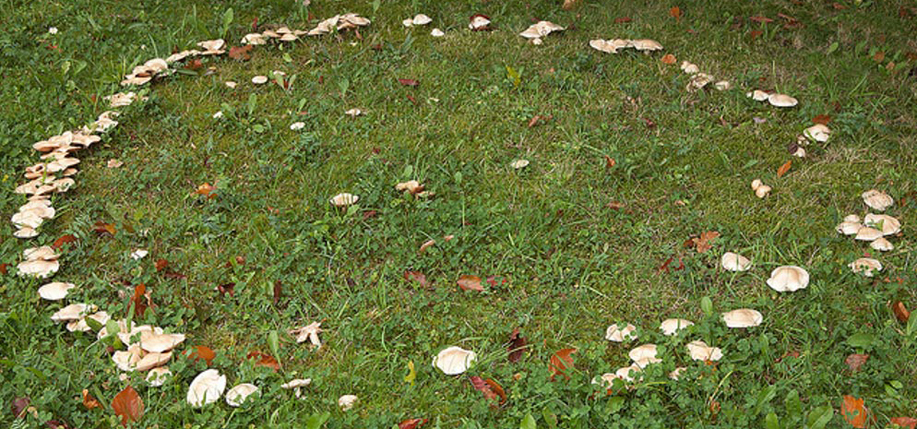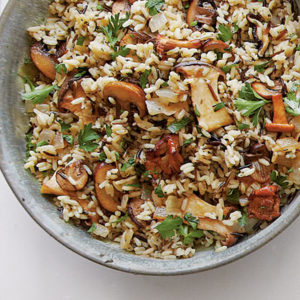From fairy rings to the perfect Thanksgiving side dish, mushrooms have fascinated people since antiquity.
℘℘℘
Alert! Savvy insider grocery tip I’ve kept secret for several decades ahead! One crisp November afternoon while shopping for my Thanksgiving feast ingredients, I was selecting perfect mushrooms one by one from an overflowing display for my yummy wild rice side dish. I was so engrossed in the task that a gentleman standing beside me went unnoticed until he commented in a low, conspiratorial tone, “Always take your mushrooms from the very bottom of the bin.”
Startled, I turned and saw a tall, elderly fellow in a tweed jacket with a loden green newsboy cap pulled down low on his brow. He leaned in a bit so no one else would hear his advice and spoke softly again: “Mushrooms grow in the dark, so the ones on the bottom never see the light and stay freshest longest.” It was then that I noticed his Irish accent. We chatted for a bit, with him telling me how he used to go mushroom hunting in Ireland (where they are abundantly found in autumn) while he filled our bags with several pounds of firm, plump, ghostly white, perfect specimens that had been hiding beneath all the others. Ever since, I have thought of him and silently thanked him whenever I buy mushrooms.
When I was a child, mushrooms didn’t appear on our dinner table very often. My Italian mom was terrified of them, remembering that her mother put a silver coin in the pan whenever she cooked those that my grandfather brought home from his forest foragings. According to Nana, if the coin turned black, it meant that one of the mushrooms was poisonous. Turns out that’s just an old folk tale, which made my mom even more leery. My Irish dad, on the other hand, loved mushrooms and always sautéed a batch with lots of butter, salt, and pepper on the rare times he took over in the kitchen. Mind you, he had to settle for canned sliced mushrooms because Mom trusted Del Monte and refused to let even one fresh mushroom through her front door – ever!
Of all the world’s foods, those musky things known as mushrooms are the strangest. Some are a nutritious food; others are deadly poisons. Some are free for the taking; the truffle variety are worth their weight in gold. You’ll find mushrooms in a supermarket’s produce section, but they’re not vegetables. And while leafy plants contain chlorophyll that enables them to photosynthesize nutrition from sunlight, mushrooms completely lack this green pigment and quite contentedly grow in the dark. There is some controversy, in fact, as to whether mushrooms are plants at all.
What we call a mushroom is really part of a complex fungus that propagates itself when moisture and temperature are right by developing fruits which release millions of reproductive spores to be carried by the wind to new locations. As the spores germinate, they become branching threads that form meters-wide webs that absorb growth nutrients from the host material. Every spore has the ability to produce its own mushroom; fortunately most do not. If each of the 1.5 trillion spores contained in a single medium-sized half-pound puffball produced an equally large offspring, the combined mass would be approximately 800 times the size of Earth!
Though emerald green is not a fungi color, mushroom hues range through the rest of the spectrum. Grocery store offerings are invariably white or brown, but the exotics come in shades of golden yellow, violet, blue, red, orange, and black. Some varieties even have gaudy polka dots. Mushrooms may look fragile, but appearances can be deceiving. With water comprising more than 90 percent of its composition, a growing mushroom is a powerhouse of strength. Such rapid absorption of water can turn a lowly mushroom into a hydraulic jack able to displace weight much greater than its own. Colonies that have popped up after a heavy rain have cracked solid cement floors!
Their ability to flourish in the dark, their rainbow hues, their amazing strength, and their rapid growth patterns fascinated our early ancestors. Since mushrooms have neither leaves nor flowers, their sudden appearance was baffling. One particular phenomena further convinced our forebears that mushrooms were magical. In Ireland, where the northern latitude makes for short days and long nights from fall to spring and where rain is a frequent occurrence, a perfect circle of mushrooms frequently appears after a heavy downpour. With the long-held and widespread Irish belief in the Little Folk, these mushroom circles are called fairy rings and attributed to a gathering of sprites who had gaily danced on the spot from midnight to dawn. And woe betide the unwary mortal who wandered into one of the enchanted rings and would be forced to dance until exhausted or, even worse, dead. Actually, the formations are created by underlying fibrous networks that take a circular shape when necessary nutrients are dispersed evenly through soil. If the net is not disturbed, the rings continue to enlarge unchecked. In Kansas, a fairy ring 600 feet in diameter has been growing since before the arrival of Columbus.
Every year, people perish from eating poisonous wild mushrooms. There is no standard for distinguishing the good from the bad. Some are harmful if eaten raw, but harmless when cooked. Others bring on digestive ills when consumed with alcohol. Aroma gives no clue, nor does color, shape, or location. The only safe bet is to always go foraging with a skilled mycologist who can accurately identify whatever you find.
Not all toxic mushrooms are deadly. Some are hallucinogenic. The most famous variety found throughout Europe and its offshore islands is the white-dotted red-capped fly agaric. These picture-pretty mushrooms symbolized luck and happiness on many Christmas cards during the Victorian era. An ancient Eurasian cult that flourished in the region where the Celts originated is said to have consumed this mind-altering fungi as part of its winter solstice rituals. A few anthropologists theorize that druid shamans may have done likewise, especially during Samhain (November) and Bealtaine (May) full moon cycles, the months when the veil between this world and the fairy world was thought to be thinnest. Irish folklore is filled with reports of people who swore they saw the Little Folk at those times. Some even claimed to have only narrowly escaped being carried off to live forever in the ancient mysterious mounds that dot the island.
Fortunately, for all who love mushrooms and are rightly wary of hunting for wild varieties, even the exotic chanterelles, morels, and porcinis, are now being cultivated and can be found in markets alongside their common white cousins. Just remember, the best selections will be at the bottom of the bin! And keep the secret to yourself. Sláinte! ♦
RECIPES
Wild Rice with Mushrooms
2 tbsp finely diced peeled carrots
2 tbsp finely diced celery
2 tbsp finely chopped onions
1 cup wild rice
1 tsp salt
2 cups chicken stock
1⁄2 lb coarsely chopped mushrooms
2 tbsp minced fresh parsley
1⁄3 cup finely chopped pecans
Over medium heat, melt 2 tbsp of butter in a heavy enamel or stainless steel 2-quart saucepan. When the foam subsides, add the carrots, celery and onions. Cover and cook for 10-15 minutes, stirring occasionally until the vegetables are soft but not brown. Stir in the cup of wild rice and salt and cook for 2-3 minutes uncovered, stirring to coat the rice with the butter. Pour in the stock, bring to a boil, cover and lower the heat to minimal. Cook undisturbed for 25-30 minutes, or until the wild rice is tender and has absorbed all the stock.
While the wild rice and vegetables are cooking, melt the remaining 2 tbsp of butter in a skillet. Add the mushrooms and parsley. Cook, stirring for 5 minutes. Add the pecans and cook for 2-3 minutes more. Stir the contents of the skillet into the fully cooked wild rice mixture. Serves 4-6.
NOTE: To make this a vegetarian dish, vegetable stock can be substituted for the chicken stock, and olive oil can be substituted for the butter.
(Personal recipe)
Beacon gaol chlogad (Mushrooms Under A Cloche)
This recipe dates from the 1700s. Served with a salad, it makes a great light meal.
1 lb small button mushrooms
1 stick butter
salt and freshly ground pepper
4 thick slices of hearty bread, crusts optional
Preheat oven to 425 F. Butter four small baking dishes. Place one slice of bread in the bottom of each dish. Arrange the mushrooms in layers on the bread, buttering each layer and sprinkling each layer with salt and pepper. Place a dot of butter on top. Tightly cover each dish with aluminum foil. Bake for 30 minutes. Serves 4.
(Irish Traditional Food by Theodora Fitzgibbon)
Note: This article was originally published in the October / November 2016 issue of Irish America.



Thank you for sharing this is very informative. This looks so delicious and I bet it tastes amazing! My family will love this. I can not wait to try this at home. This is a great way of introducing healthy foods into our menu. Thank you. This is a must-try!
Mushroom is really so nice thing. I’m a mushroom lover. Actually I want to try every recipe that makes with mushrooms. It looks delicious.
We can use mushroom in a various way. We can take it as a recipe, we can take it as medicine and also some other ways. I’m a mushroom lover, I love this article. Thanks for sharing.
Interesting story! I am a fan of mushrooms and I love everything related to them. I’ll definitely try to cook mushrooms according to your recipe next weekend when we have a small feast!
Your recipe is mouthwatering. I am a mushroom fan and i love eating any kind of dish with it. Im gonna try this recipe soon and i am sure my family will love this. Thank you for sharing, this will add on my list.
Try this with gluten free bread like Canyon Bake House Mountain White.
Add broken bread, cooked Jones gluten free sausage, thyme, sage etc